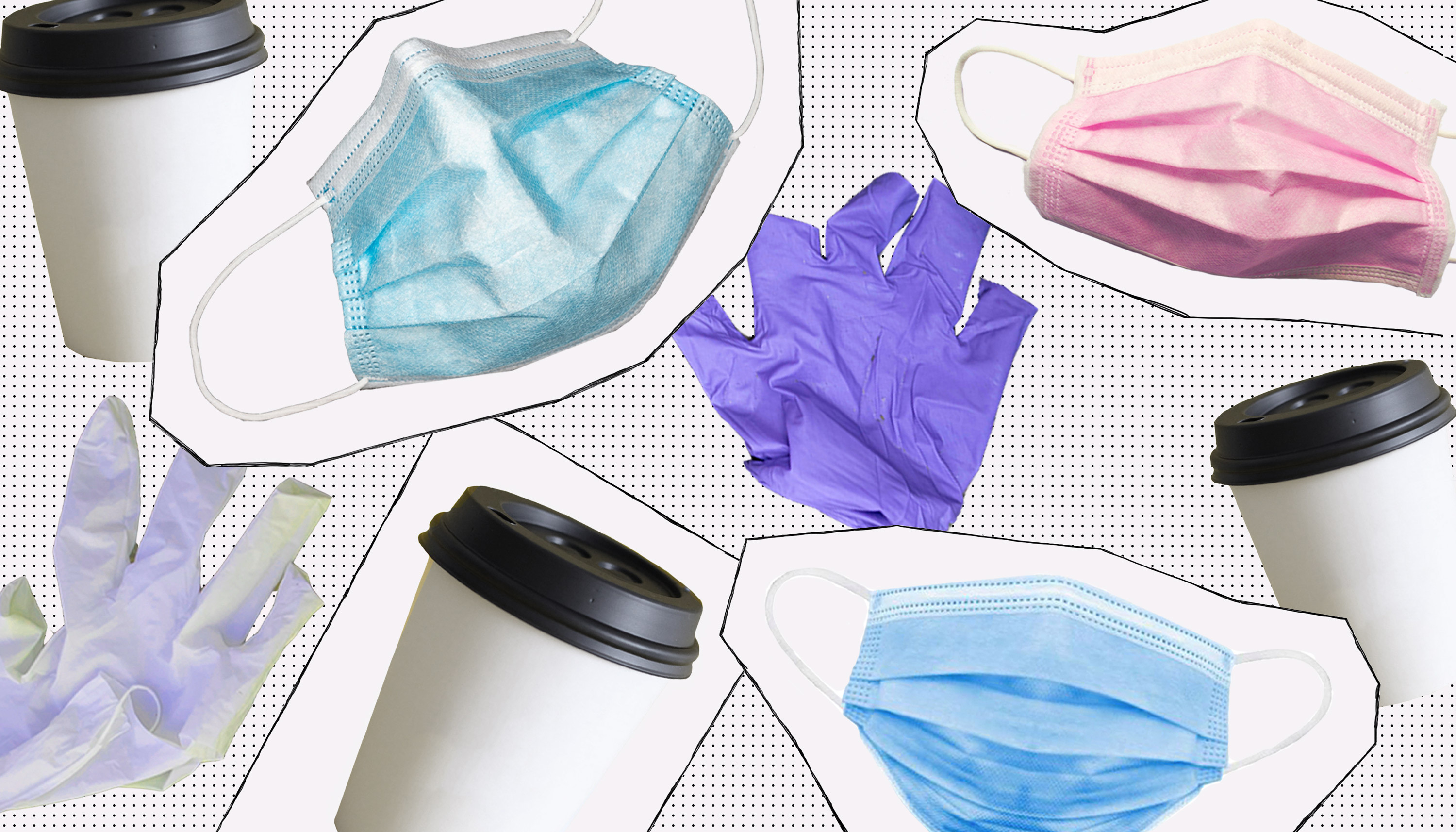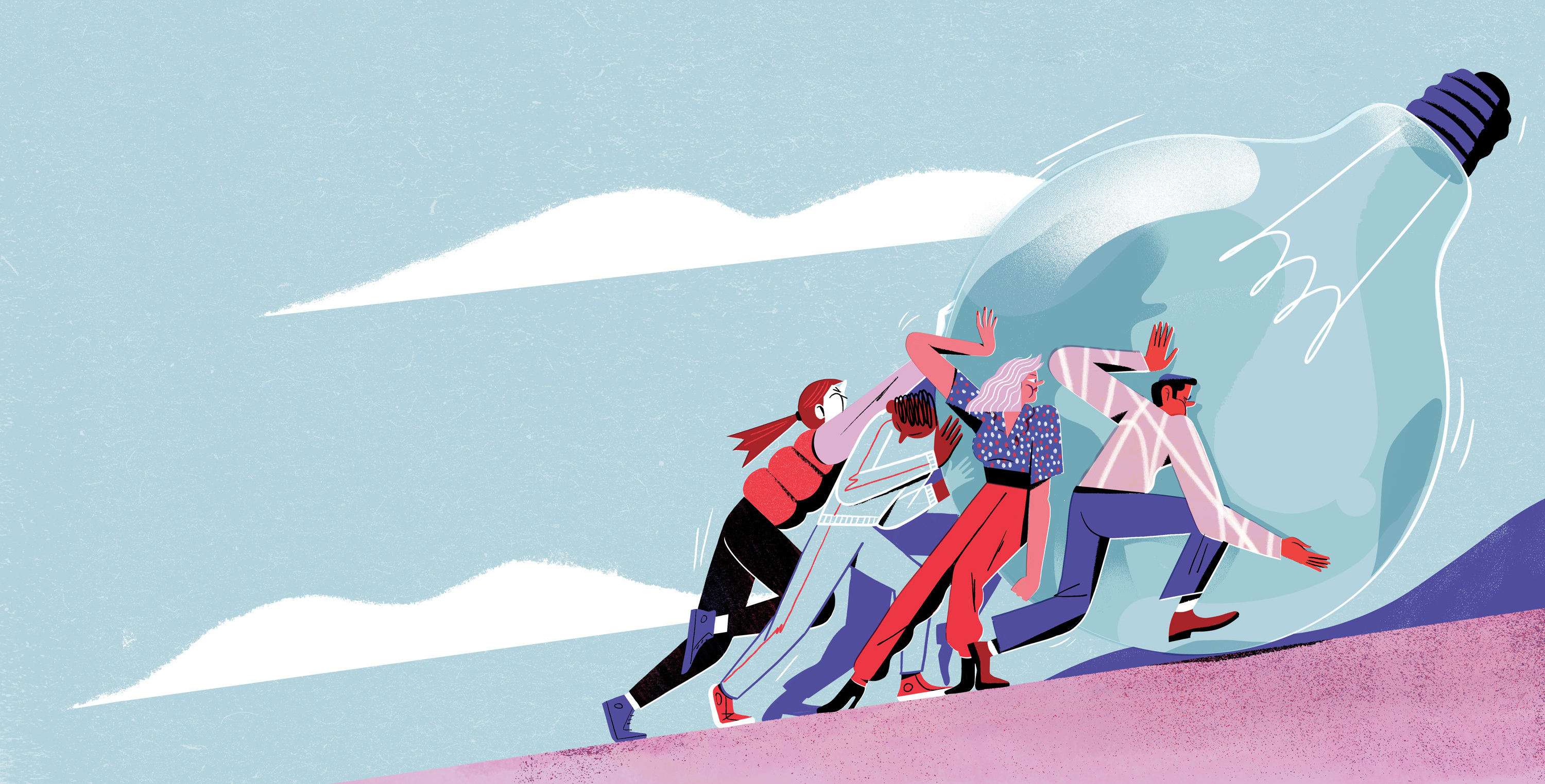What disposable coffee cups can teach us about COVID-19 waste

The landscape of litter has shifted over the past year. The pandemic has made disposable masks and gloves as commonplace as plastic bottles and cigarette butts on city streets.
COVID-19 has fueled a whole new waste stream, putting additional plastics and other material into the environment and harming ecosystems, animals, and human communities as a result.
At the same time, those masks and gloves and other personal protective equipment (PPE) are critical to slowing the progression of the pandemic and keeping our front-line workers safe. They’re disposable, yet they’re indispensable—presenting us with a difficult tension between our immediate public health needs and the long-term repercussions of this massive waste problem. Gloves floating in the ocean like seaweed threaten already endangered marine species and pollute the world’s tap water, in time delivering new risks to human health.
But an apparent lose-lose situation like this can also become a rich opportunity area for human-centered design. How might we design PPE that is effective at keeping people safe without polluting the environment?
One source for models and inspiration lies in another realm entirely: coffee shops. By exploring other industries—a design tactic known as analogous research—leaders can get inspired by how others have addressed similar questions. Looking to analogs allows designers to move beyond their expertise to see issues with fresh eyes, building new levels of understanding to their present design challenge.
The to-go cup has a lot to teach about disposability, desirability, hygiene and convenience; and as a consumer product, it’s seen more sustainability-minded innovation than medical disposables. By looking at the ways the coffee cup has evolved, we can gain new insight for understanding what is possible in the heavily regulated, fast-paced, and high-pressure world of medical supplies, where safety and sustainability are both paramount.
Next-generation solutions for the humble to-go cup
As a product, the disposable cup has gone through several eras of change relative to design and behavior. Initially, to-go cups enabled convenience and efficiency. But nearly all of the to-go cups that exist today are made of a combination of materials that make them next to impossible to recycle or compost. They were designed without any thought to where they would end up after being used, aside from the landfill or incinerator.
Environmental concerns then sparked a movement encouraging consumers to bring their own reusable cup. Committed environmentalists were willing to do this, despite the personal compromise on convenience, but the trend failed to scale and meaningfully reduce waste. Some cups are now made of materials that can biodegrade or be composted, but both processes are difficult to achieve at a global scale due to cost and lack of access and infrastructure.
In 2018, OpenIDEO launched a design challenge to invite new ideas for material and processes that could lead us into a more sustainable era for to-go beverage containers. The NextGen Cup Challenge represented a new horizon for sustainability that goes beyond the product to offer a vision for a system and business model where circularity is the driving principle. Contrary to the linear “take-make-waste” model of manufacturing that has characterized industrial products for centuries, a circular economy designs waste and pollution out of the value chain, keeping products and materials in repeated use, and regenerating our natural systems.
The NextGen Cup Challenge asked the question: How might we design the next generation fiber cup to be recoverable on a global scale, while maintaining the performance standards we know and trust? The Challenge, managed by OpenIDEO, was part of the NextGen Consortium, a global initiative convened by Closed Loop Partners and founding partners Starbucks and McDonald’s. The 12 winning solutions—categorized into innovative cup liners, new materials, and reusable cup service models—have the potential to turn the 250 billion fiber to-go cups used annually from waste into a valuable material in the recovery system.
When we see masks and gloves in the gutter, we can imagine a similar trajectory for innovation. But there’s a different set of barriers—psychological, regulatory, supply chain, and safety—to contend with. The question becomes: How can we apply circular design principles in the healthcare industry to enable a more robust and resilient supply chain of PPE, which can be safely reused to become regenerative rather than wasteful? Based on the learnings from the NextGen Cup Challenge, we see two rich areas for design: redesigning PPE products to be sustainable and adopting a systems-level perspective.
Redesign or repurpose the product itself
The NextGen Cup Challenge sought manufacturing and material innovations and technologies that improved the existing to-go cup, making it more valuable at the end-of-life, whether through recycling, composting, or biodegrading. For consumers, baristas, and retailers, these new ideas would require little behavior change—they offered the same convenience of the single-use cup, just made of something new and more sustainable. SoluBlue, for example, is a winning NextGen Cup Challenge solution that produces plant-based, food-grade, and non-toxic materials that quickly biodegrade after use, and can replace some forms of single-use plastics.
The same concept is hopefully being applied to PPE: Recently, the Canadian government announced two business challenges for the private sector that offer funding for PPE that won’t end up in landfills. One calls for businesses to develop compostable surgical masks and respirators that can be mass-produced for healthcare workers. The second challenge seeks technologies for "efficient and cost-effective" PPE recycling, which can transform potentially contaminated PPE into "valuable materials that can further be used in manufactured products.”
If Solublue can make a cup that biodegrades after one use, why couldn't we do the same with a face mask or a pair of gloves? Furthermore, as we consider redesigning PPE to be safe and environmentally-friendly, there is not only an opportunity to redesign the product, but to extend its value to other products. Binish Desai, for example, is an entrepreneur and environmental activist based in New Delhi who is transforming used PPE into bricks for homes and factories. Desai installs bins outside of apartment buildings and retail shops to collect used masks and gloves, then leaves them untouched for 72 hours. The gear is then sanitized, shredded, and sanitized again. Lastly, the sanitized scraps are mixed with paper sludge and a binding agent to form various brick molds.
Good intentions must be coupled with systems thinking
Sometimes the product alone—or a byproduct of it—can’t solve the problem. We’ve had the technology to produce a compostable cup or mask since long before COVID-19. But as demand for PPE outstrips supply, it becomes critical to consider the system surrounding the product to enable recoverability and reusability. In neglecting to design for how a product fits into the larger ecosystem, we risk exacerbating the issue. When items are improperly disposed of (for example, when a compostable cup is recycled, which is common) it can contaminate the entire bin, dumpster, and truckload with byproducts that devalue the actual recyclable material. This sometimes results in full batches of recycled materials being removed from the recycling line and sent to landfills due to a single incompatible cup, as it has potentially contaminated the entire collection.
New solutions need to be designed in tandem with new infrastructure, or designed to work within the existing system. Muuse, a NextGen Cup Challenge winning idea, created a platform for reusable cups that works within restaurant networks with the goal of eliminating single-use waste. Before the pandemic, consumers could “borrow” a cup from one of Muuse’s cafe partners, such as Equator Cafe in San Francisco, by scanning the QR code on the cup. Within the designated time period, the customer returned it to any of Muuse’s 40 cafe partners in San Francisco. Muuse inspected and cleaned the cups, and collected late fees through tracking technology, seamlessly integrating into the way the restaurant system operates.
Muuse can offer inspiration for redesigning PPE to be both safe and regenerative. Most people know that doctors wear sterile gloves during surgery. But fewer realize that surgeons can be particular about the gloves they use (e.g. latex, non-latex, nitrile, vinyl). In design research, we’ve noticed that some physicians prefer specific layered combinations of gloves, such as latex over non-latex or vice versa. When we look at other trades, many professionals have their own pair of reusable, personalized gloves, like welders, chefs, and athletes, that are sustainable, help them excel in their craft, and keep them safe.
How might we enable this for doctors? What new innovations—in reusable design but also in the washing and sanitation procedures that already exist in hospitals for bedding or scrubs —might achieve safety and waste elimination, while also enhancing physician desirability and performance? To support frontline workers during the coronavirus pandemic, Ford pivoted to produce face masks, shields, and ventilators using the same air filtration technology the automaker uses to produce the ventilated car seats found in F-150 trucks, putting their existing materials towards an urgent global need. Taking a cue from Muuse, what if a new system was designed to enable frontline workers to return these masks to hospitals, and hospitals to then return them to Ford? This reusable system would be keeping key materials in use in both the auto and medical world.
A future that is designed for both sustainability and safety
Alarming photos of masks and gloves scattered on sidewalks and washed up on beaches are a reminder that COVID-19’s impact spreads far wider and deeper than we yet realize. The virus and its reverberations have touched every aspect of life on the planet. But human safety does not have to come at the expense of environmental damage and climate change.

Design encourages us to look to unlikely analogs, like the unassuming and ubiquitous to-go cup, to be inspired to create a world in which safety and sustainability can co-exist, offering protection to all.
Words and art



Subscribe

.svg)









